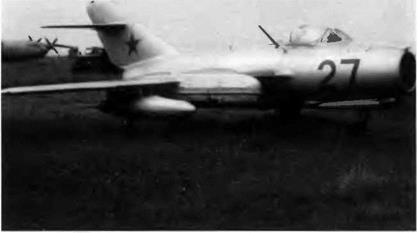Ye-50
The Ye-50 was designed in 1954 Although it was a member of the Ye- 2/Ye-2A family, it differed from them in many points First its power plant included the Mikulin AM-9Ye turbojet rated at 3,725 daN (3,800 kg st) and the Dushkm S-155 liquid propellant rocket engine capable of 1,275 daN (1,300 kg st) The AM-9Ye turbojet differed from the production AM-9B in several details that broadened its combat operating range (altitude and speed) and took into account the contribution of the rocket engine Second, the fuselage had to be lengthened to make room for the three propellant tanks for the rocket engine (К-fuel A – acid, T-hydrogen peroxide) as well as the combustion chamber above the turbojet’s exhaust nozzle. The accessory drive and turbopumps of the rocket engine were located in the fairing of the fin base The nozzle throats for the rocket engine and the turbojet lined up Underneath the fuselage two lines for the combat emergency jettison device—treated on the inside against corrosive acids—ran across the skm opening into the same plane as the nozzle throat On the other hand the forward fuselage, the wing, the slab tail, and the gear were not modified because those components were the subject of detailed engineering work with the Ye-2 and were at that time mastered by the manufacturing units The Ye-50 was armed with two NR-30 cannons
Three prototypes were built from 1955 to 1957 The Ye-50-1 rolled out in December 1955 It was first piloted by V. G Mukhin of the LII MAP on 9 January 1956 (the same day as the Ye-5) and first lit up its rocket engine in the air on 8 June The Ye-50-1 factory tests halted on 14 July after eighteen flights when the aircraft landed short of the runway and was destroyed.
Ye-50/1; second from left, the dotted line shows the Ye-50/2 modifications; second from right, side view of the Ye-50/3 (MiG О KB four-view drawing)
The Ye-50/3 differed from both the Ye-50/1 and the Ye-50/2 by a noticeable lengthening of the fuselage forward section.
The Ye-50/3 also differed from the two other prototypes by the new shape of its rear fuselage, which resulted in a shortened rudder
The Ye-50-2 was rapidly completed, and V. P. Vasin (also of the LII MAP) was put in charge of the tests. The Ye-50-2 differed from the first prototype in the modified shape of the rear end and in the patch dubbed the “knife" placed along the trailing edge of the rudder to increase the vertical fin area. Several unofficial altitude and speed records were beaten with the rocket engine in use. On 17 June 1957 Vasin climbed to 25,000 m (82,000 feet) and a little later reached Mach 2.23 or 2,460 km/h (1,328 kt).
The Ye-50-3, built in 1957, had a larger kerosene tank and a smaller hydrogen peroxide tank than its predecessors. The former cell-type tank for kerosene was replaced by a sheet metal tank fitted with a transfer pump. Also, the fuselage nose was lengthened, and the air intake lips were sharpened. The air intake cone had a double angle, and the rear end of the fuselage was modified once more. During a high-altitude flight of this prototype with N. A Korovin of the Nil WS at the controls, part of the tail fin caught fire. The aircraft became uncontrollable and went into a spin. The pilot ejected; unfortunately, the mechanism to separate the pilot’s seat and the canopy did not work, and the pilot was killed.
After reviewing carefully the reasons for the many shortcomings of rocket engines and their systems, it was decided to discontinue the Ye – 50 project. But the development of a new generation of fighters equipped with auxiliary power plants proceeded after a complete reappraisal of the basic data concerning this kind of power unit. The goals of this new effort were to increase the effectiveness of the rocket engine’s control system and to safeguard the pilot and maintenance personnel (both aboard the aircraft and in the storage facilities) against any toxic components of the rocket engine propellants.
Specifications
Span, 8.109 m (26 ft 7,2 in); length (except probe), 13.625 m (44 ft 8.4 in) for the Ye-50-1; 14.85 m (48 ft 8.7 in) for the Ye-50-3; fuselage length (except cone), 12.32 m (40 ft 5 in) for the Ye-50-1; 12.715 m (41 ft 8.6 in) for the Ye-50-3; wheel track, 2.679 m (8 ft 9.5 in); wheel base, 5.22 m (17 ft 1.5 in); wing area, 21 m2 (226 sq ft); takeoff weight, 8,500 kg (18,735 lb); wing loading, 404.8 kg/m2 (83 lb/sq ft).
Performance
Max speed, 2,460 km/h (1,328 kt); climb to 10,000 m (32,800 ft) in 6.7 min; to 20,000 m (65,600 ft) in 9.4 min; static ceiling, 23,000 m (75,440 ft); zoom ceiling, 25,600 m (83,970 ft); landing speed, 280 km/h (151 kt); range, 450 km (280 mi); takeoff roll, 900 m (2,950 ft); landing roll, 860 m (2,820 ft).











